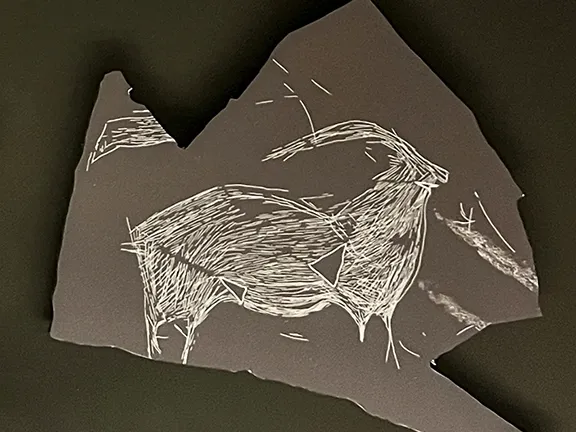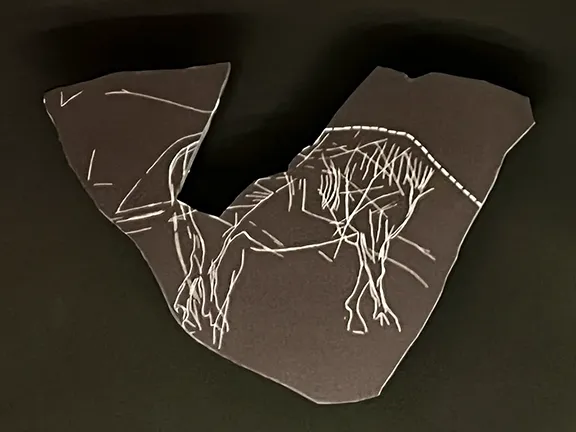Levantine Cave Art
Levantine Cave Art during the Gravettian and Solutrean
The Parpallo cave (Gandia, Spain) is one of the most important Palaeolithic sites in the Spanish Mediterranean region. It is characterized by portable art whose archaeological sequence covers a period from about 29,000 to 11,000 BC and consists of 5,034 plaquettes with 6,245 engraved or painted surfaces, decorated with black and different shades of red and yellow pigments. The artists used natural pigments made from natural iron oxides such as haematite and goethite.
By Nick Nutter on 2024-02-16 | Last Updated 2025-05-20 | Levantine Cave Art
This article has been visited 3,708 times

The Feasome Aurochs - circa 25000 BC
Aurochs during the Gravettian
The earliest examples of cave art in Parpallo Cave are from the Gravettian and early Solutrean periods, in particular, a depiction of an aurochs. Here we see a focus on the forward part of animals with the hindquarters barely discernible. The head is small compared to the body and narrows to a small snout. Forward tilting rectilinear horns are clearly depicted whilst the hooves are simply depicted with open linear strokes.
Do you enjoy my articles? For your reading pleasure, this website does not carry third party ads. You could help me write more articles by buying me a cup of coffee.
Auroch Study


An Auroch Study - circa 25000 BC
The aurochs is an extinct cattle species of cattle, considered to be the wild ancestor of modern domestic cattle. With a shoulder height of up to 180 cm bulls and 155 cm in cows, it was one of the largest herbivores in the Holocene; it had massive elongated and broad horns that reached 80 cm in length. Unlike modern domesticated cattle, the aurochs was a fierce animal, both feared and revered by hunter gatherers. A hunt that brought in an aurochs would have been a cause for celebration by the whole band and its butchery would have been part of a sacred ceremony. The most important part of the animal from a culinary point of view would be its body whilst from a hunter's perspective, intent on avoiding injury or worse, the horns would be most feared, hence the emphasis on those two features in the depiction seen here.
Goats in the Solutrean


Goats in the Solutrean - circa 20000 BC
Moving into the Solutrean period, goats are commonly represented. The technique for depicting these, and other animals at this time, is to use multiple, repeated strokes to give the animal greater volume. It is very unusual to see any representation of landscape in any period of cave art, however, I like to think that the 'mountain' behind the goat in the top right sketch shows the environment in which this animal is found.
Depiction of Iberian Ibex


Ibex circa 18000 BC
The Iberian ibex was an important source of meat for hunter gatherer bands in the Iberian Peninsula. This agile animal was adept at avoiding predators, well able to ascend and traverse near vertical rock faces where humans could not follow easily. The ibex was hunted seasonally and, during the Solutrean period, hunter gatherers developed specialised ibex hunting sites, specific areas to which ibex could be driven and from which they could not easily escape thereby making their dispatch more efficient.
Life Cycle of Deer - Solutrean Style


Deer with Fawn circa 18000 BC
The life cycle of the animals on which they depended was obviously of great importance to the hunter gatherers and there are many indications that animals were culled at specific times of the year to avoid exterminating them entirely from any one area. It was not until the later, Magdalenian period, that scenes of animal domesticity were commonly depicted in cave art. This scene, of a deer suckling her fawn whilst concealed in long grass, was created during the Solutrean period and is very unusual.
The First Iberian Horses


Iberian Horse in profile
The Sorraia, a small, dun coloured wild horse native to southern Iberia appeared in the Iberian Peninsula shortly before 30,000 BC. It became an important food source for hunter gatherer communities. This example is an early image of an Iberian horse. The head is a characteristic shape with a stepped mane and a nose shaped somewhat like a duck's beak. Overall, the head appears very similar to the Andalusian and Lusitano horse, both of which are considered native to the Iberian Peninsula.
The Iberian Lynx


Iberian Lynx circa 17000 BC
Today, the lynx is almost extinct in the Iberian Peninsula. 25,000 years ago, when this image was produced, it was more common. Although not regularly hunted for food, as part of the landscape, the animal was keenly observed by the humans that hunted the area, if only as a competitor for prey. This remarkably perceptive portrayal shows a lynx, recognised by its spotted fur represented by short parallel strokes, pouncing up to the neck of a long-horned goat.
Dhole or Dog?


Dhole or Dog circa 17000 BC?
Of a similar period, we have a pair of animals indulging in a typical canine activity. The animal to the left is raising its nose to sniff the behind of the animal to the right.
Unfortunately, part of the plaque is missing so we can only see the hind legs and tail of the right hand animal. What is doubly intriguing is that this is another rare example of animal behaviour, it is well before dogs were domesticated in the Iberian Peninsula and may represent the activities of a pair of dholes.
The dhole was related to the jackal and disappeared from Iberia about 18,000 years ago and is now confined to Central, South, East and Southeast Asia where it is known as the Asian wild dog. The shape of the head is more reminiscent of a dhole than that of a wolf, the other canine roaming the wilds of Iberia during this period.
Early Human Forms


Female Form circa 16000 BC
Representations of the human form are extremely rare in Palaeolithic cave art which is why this engraving, originally emphasised by red ochre, is so exciting. It is a stylised female figure showing only the body, hips, and legs and is svelte like compared to some of the so called 'venus figurines' we see from this period.
The artist used just eight lines to create the figure and must have been pleased with the result.
The Magic Trap


Magic Trap - Solutrean
The Palaeolithic artist did not confine him/her self to animals. One of their favourite subjects was the spiral or successive concentric lines, filled with short strokes that draw the eye to the centre of this 'magic trap'. Was it a created as a game, a curious optical effect, purely decorative, or as part of some ceremony? We shall probably never know.
Billy Goat circa 16000 BC


Billy Goat circa 16000 BC
Having proved themselves capable of optical effects, the cave artist now moves on to using those effects in the depiction of animals round about16000 BC. Take a look at this billy goat. Repeated strokes produce a highly distinctive visual effect.
Animal Associations


Horse and Doe - Solutrean
One of the features of Palaeolithic art is the association of animals of the same or different species. In this plaque we can see a horse superimposed on an engraving of a doe with two fawns. On the reverse of this plaque we can see a horse eating.
In early cave art, animal outlines were often doubled up. This technique disappeared during the later Magdalenian period.
Museum of Prehistory Valencia, Spain
The original limestone portable art plaques can be seen in a display at the Museo de Prehistoria de Valencia.
Rather than have the observer try to decipher barely discernible outlines on small pieces of limestone, modern spectroscopic means have been used to bring out the individual designs in great detail. Those designs have been reproduced in white on slate and the results are now displayed in chronological order.
I would like to thank the staff at the Museum of Prehistory in Valencia for constructing such an informative and detailed display and allowing Julie and myself to spend some hours photographing the plaques.
Do you enjoy my articles? For your reading pleasure, this website does not carry third party ads. You could help me write more articles by buying me a cup of coffee.
 2: Levantine Cave Art - Magdalenian
2: Levantine Cave Art - Magdalenian